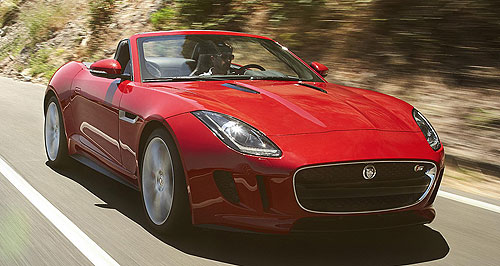Make / Model Search
Future models - Jaguar - F-TypeAIMS: Hot Jaguar drop-tops on show at SydneyHot item: Jaguar's XKR-S convertible (left) will sit alongside the highly anticipated F-Type at the Sydney show. All-new F-Type to sit alongside XKR-S convertible on Jaguar's Sydney show stand16 Oct 2012 JAGUAR will flaunt a pair of its hottest convertibles at the Sydney motor show this week, with its all-new F-Type two-seat sportscar and fire-breathing XKR-S to appear side-by-side on the British brand's stand. The latest MY2013 versions of Jaguar's XF and XJ luxury sedans will also be shown at Sydney, packing new powertrains that improve fuel efficiency by up to 11 per cent plus interior technology upgrades. Australian pricing for the new F-Type, arriving in Sydney fresh from its world debut at the Paris motor show, will also be announced and is expected to kick off from around $190,000. For comparison the XKR-S, the most powerful convertible Jaguar has yet produced, sells for a cool $363,500 plus on-road costs – but with only 10 examples bound for Australia the Sydney show will be the closest most Australians will get to one. While the XKR-S may have the bigger guns under the bonnet, the smaller, lighter F-Type can outrun it when fitted with the flagship supercharged V8 engine.  Left: 2013 Jaguar XF and XJ. Left: 2013 Jaguar XF and XJ.The 364kW/625Nm V8 F-Type is able to hit 100km/h in just 4.3 seconds – a tenth of a second quicker than the beefier 405kW/680Nm XKR-S – and both cars share an electronically limited 300km/h top speed. At 4470mm long, the F-Type is 504mm shorter than the XK and rides on a 2622mm wheelbase that is 130mm smaller than that of the XK but the new car is wider at 1923mm and 33mm lower at 1296mm, giving it a purposeful stance, while its 200-litre boot capacity matches the XK. The base F-Type weighs 99kg less than the lightest XK convertible, while the range-topping V8 is 88kg less hefty than the XKR-S and weight distribution has been aided by locating the battery and windscreen washer fluid tank in the boot. Entry-level F-Types come with a 250kW/450Nm supercharged 3.0-litre V6 petrol engine, while mid-range cars have a version of the same powerplant tweaked up to produce 280kW and 460Nm. All drive the rear wheels through an eight-speed ‘quickshift’ automatic transmission that can be operated manually using the centre console selector or steering wheel paddles. The F-Type’s body is 10 per cent stiffer than that of the XKR-S and the steering rack is the quickest Jaguar has yet fitted to one of its cars. Jaguar first gave the world a preview of the F-Type at the Frankfurt motor show last September with the hybrid-powered C-X16 coupe concept. The company resisted the temptation to reference its classic E-Type in the design, even dropping the oval grille design that featured on most of its sportscars over the decades but apart from the transition to soft-top, the production F-Type remains faithful to the C-X16. Carried over from the concept are the chrome-rimmed mesh grille flanked by gill-like air intakes, triangular headlights framed by strip-like LED daytime running lights and indicators, plus vents on the bonnet and front guards. The bonnet, front guards and doors also appear unchanged, while the front splitter and side-skirt designs have not been lost in translation, nor have the Aston Martin-style flush doorhandles.  Read more27th of September 2012  Paris show: Jaguar F-Type V8 outpunches XKR-SFull reveal of Jaguar’s F-Type sportscar in Paris puts XKR-S in the shadeAll future models Alfa Romeo Alfa Romeo Abarth Abarth Alpine Alpine Alpina Alpina Audi Audi Aston Martin Aston Martin BMW BMW Bentley Bentley Chery Chery Brabham Brabham Chrysler Chrysler Chevrolet Chevrolet Cupra Cupra Citroen Citroen DS DS Dodge Dodge Fiat Fiat Ferrari Ferrari Foton Foton Ford Ford Great Wall Great Wall FPV FPV Haval Haval GWM GWM Honda Honda Holden Holden Hummer Hummer HSV HSV Infiniti Infiniti Hyundai Hyundai Jaguar Jaguar Isuzu Isuzu Kia Kia Jeep Jeep Land Rover Land Rover Lamborghini Lamborghini Lexus Lexus LDV LDV Mahindra Mahindra Lotus Lotus Mazda Mazda Maserati Maserati Mercedes-AMG Mercedes-AMG McLaren McLaren MG MG Mercedes-Benz Mercedes-Benz Mitsubishi Mitsubishi Mini Mini Opel Opel Nissan Nissan Peugeot Peugeot Pagani Pagani Proton Proton Porsche Porsche Renault Renault Ram Ram Rover Rover Rolls-Royce Rolls-Royce Skoda Skoda Saab Saab SsangYong SsangYong Smart Smart Suzuki Suzuki Subaru Subaru Toyota Toyota Tesla Tesla Volvo VolvoF-Type pricing
Motor industry news |
Click to shareJaguar modelsResearch Jaguar All future models Alfa Romeo Alfa Romeo Abarth Abarth Alpine Alpine Alpina Alpina Audi Audi Aston Martin Aston Martin BMW BMW Bentley Bentley Chery Chery Brabham Brabham Chrysler Chrysler Chevrolet Chevrolet Cupra Cupra Citroen Citroen DS DS Dodge Dodge Fiat Fiat Ferrari Ferrari Foton Foton Ford Ford Great Wall Great Wall FPV FPV Haval Haval GWM GWM Honda Honda Holden Holden Hummer Hummer HSV HSV Infiniti Infiniti Hyundai Hyundai Jaguar Jaguar Isuzu Isuzu Kia Kia Jeep Jeep Land Rover Land Rover Lamborghini Lamborghini Lexus Lexus LDV LDV Mahindra Mahindra Lotus Lotus Mazda Mazda Maserati Maserati Mercedes-AMG Mercedes-AMG McLaren McLaren MG MG Mercedes-Benz Mercedes-Benz Mitsubishi Mitsubishi Mini Mini Opel Opel Nissan Nissan Peugeot Peugeot Pagani Pagani Proton Proton Porsche Porsche Renault Renault Ram Ram Rover Rover Rolls-Royce Rolls-Royce Skoda Skoda Saab Saab SsangYong SsangYong Smart Smart Suzuki Suzuki Subaru Subaru Toyota Toyota Tesla Tesla Volvo VolvoF-Type pricing
Motor industry news |











Facebook Twitter Instagram